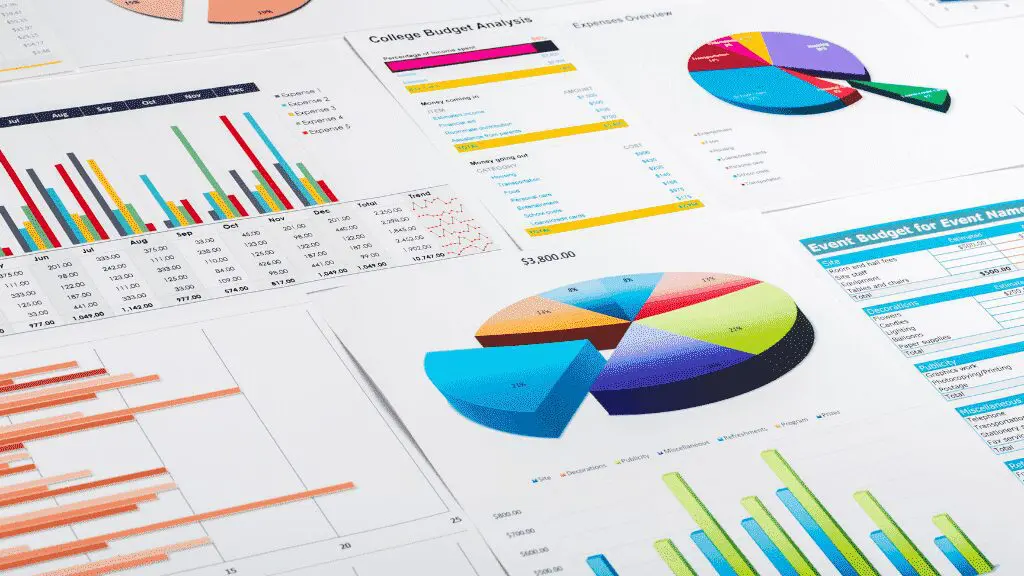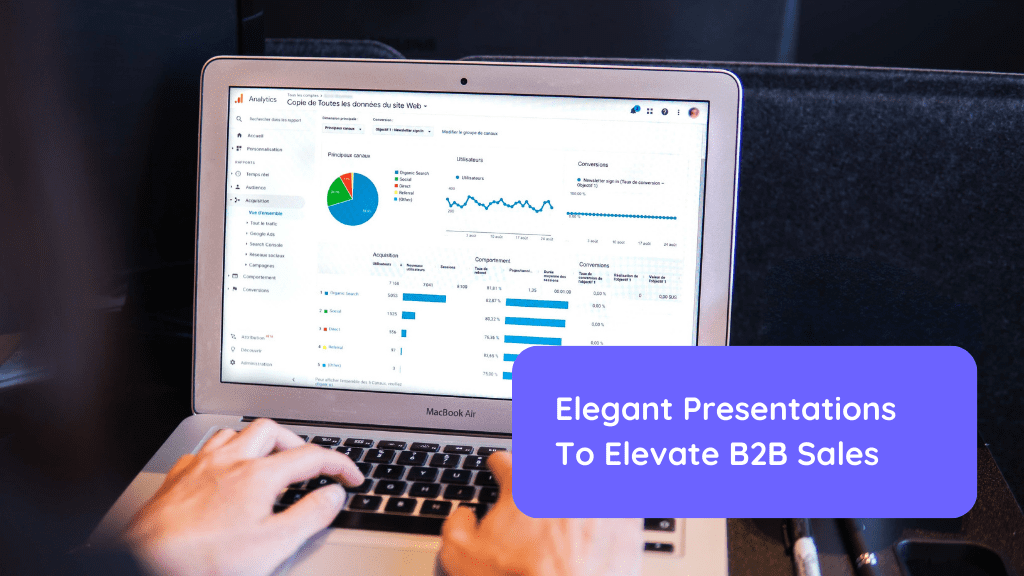Elegant presentations can elevate B2B sales. Presenting content in an appealing way helps achieve the goal of any presentation: to encourage people to take action and respond favourably. A well-designed presentation should be visually appealing, engaging, easy to understand, and easy to follow. It also needs to deliver clear and relevant information that resonates with your audience. Here are some B2B Presentation Statistics:
85% of B2B decision-makers believe that a well-structured presentation significantly influences their purchasing decisions.
90% of B2B professionals believe that visually appealing presentations are more effective than text-heavy ones.
Over 70% of B2B salespeople utilize tablets or other mobile devices for their presentations to enhance interactivity.
Let’s dive into and understand how to improve the sales presentation.
The Art of Visual Appeal
The art of visual appeal is a key part of creating elegant presentations. You can create elegant B2B sales presentations with the help of CustomShow. You can’t rely on your words alone to convince clients, you have to use the right visuals and layout in order that they can understand and appreciate your message.
Select elegant templates, color schemes, and typography for slides: Choose a template that’s both visually appealing and appropriate for your audience (for example, if you’re presenting at an industry conference then choose an abstract theme rather than one with lots of images).
Use colors that complement each other but don’t clash; avoid choosing too many shades within one presentation because this makes it hard for viewers’ eyes to focus on any particular element at any given time.
The same goes for fonts, choose two or three different ones throughout your deck rather than using all caps throughout every slide because this will make everything feel disjointed from slide to slide.
Content That Resonates

It’s no secret that content is king when it comes to B2B sales presentations. According to Hubspot, 59% of B2B buyers say they rely on social media for information about brands, products, and services. This means that your brand needs compelling narratives and messages in order to break through the clutter and get noticed by prospects at all stages of the buying cycle. Here’s how to craft content that leaves a lasting impact:
Relevance to the Audience: The first rule of resonating content is understanding your audience’s pain points, needs, and aspirations. Tailor your content to address these aspects directly. For instance, if you’re presenting a new software solution, highlight how it specifically streamlines the recipient’s workflow, saving time and resources.
Emotional Connection: B2B sales presentations are not immune to the power of emotion. Sharing stories of how your product or service positively impacted other businesses can create an emotional connection. For example, recounting how a struggling company turned its fortunes around with your solution can inspire trust and empathy in your audience.
Clear Value Proposition: Make it crystal clear why your offering is valuable. Your content should communicate the unique benefits and advantages of your product or service. Providing concrete examples of the value you bring can solidify your message. Identify these values in your product development process and promote them after the launch. For instance, if you’re selling a project management tools, showcase how it helped a company complete projects 20% faster, leading to cost savings.
Simplicity and Clarity: Avoid jargon and complexity. Your content should be simple and easy to understand. If your audience has to decipher complex terminology or concepts, your message may get lost. Utilize clear language and straightforward explanations, ensuring that your content is accessible to everyone.
Mastering Delivery

Let’s begin with a few guiding principles. First, you must understand the importance of delivery techniques in making dynamic presentations elegant. The right words and body language can elevate your creative presentation from good to great, while poor delivery will make even the best content seem lackluster at best, or unprofessional at worst.
Next, we’ll look at some specific tips for delivering elegant B2B presentations:
Storytelling: Use stories to illustrate key points rather than just reciting facts and figures. Stories engage listeners on an emotional level and make it easier for them to remember what they’ve heard later on down the line–which means less time spent repeating yourself!
Body Language: Be sure that your nonverbal cues match up with what you’re saying verbally (or vice versa). If someone says something serious but is smiling broadly throughout their speech, this sends mixed signals; likewise, if someone looks serious when talking about something funny or lighthearted, it may come across as insincere or disingenuous instead of sincere!
Engagement with the Audience: Engage with your audience throughout the great presentation. Encourage questions, discussions, and feedback. Address concerns and comments promptly. Engaging your audience makes them feel like active participants in the presentation, rather than passive listeners.
Leveraging Technology
Using technology to create an elegant presentation is a great way to elevate your B2B sales presentations. Technology can help you create a more dynamic and engaging experience for your audience, allowing you to get your message across in a way that’s both memorable and impactful.
There are many presentation tools available today that offer elegant features, such as:
- Customizable templates that make it easy for even non-designers like myself to make beautiful slideshows;
- Interactive elements like Svgs, images, videos or graphs that allow viewers to interact with the content on screen;
- Real-time collaboration so multiple people can work on one document at once without having access issues (like having two different versions).
Audience Engagement and Interaction

The goal of an elegant presentation is to engage the audience in a way that makes them want to stay and listen. This can be accomplished by incorporating interactive elements into your presentation, such as Q&A sessions or discussions.
During one of our sales meetings, we had several members of our customer service team present on how we handle customer issues. One member talked about how she handles customer complaints via email, phone calls and social media platforms like Facebook and Twitter.
The group then discussed ways they could use these tools more effectively when responding to customers’ concerns so they could better resolve issues before they escalated into larger problems for our company or clients’ businesses.
This type of interaction helps create buy-in among attendees because it gives them ownership over the process; when everyone feels invested in what’s being presented, it’s much easier for them to accept new ideas without feeling threatened by change and this kind of buy-in leads directly toward higher sales results!
Measuring Success
To gauge the effectiveness of your B2B presentations, you need to rely on data-driven metrics and key performance indicators (KPIs). Here’s how to measure success:
Audience Engagement Metrics: Monitor key engagement metrics, such as the average time spent on your presentation, interaction rates (e.g., responses to polls or Q&A sessions), and the number of questions asked. High engagement suggests that your audience found the content interesting and valuable.
Conversion Rates: Measure the conversion rates related to your B2B presentation. This could include the number of leads generated, deals closed, or specific actions taken by the audience, such as signing up for a trial or requesting a demo. A successful presentation should lead to concrete conversions.
Brand Awareness and Authority: If your presentation has positively impacted your brand’s awareness and authority, it’s a success. Measure changes in brand recognition and industry influence post-presentation.
Post-Presentation Actions: Monitor the actions your audience takes after the presentation. Did they visit your website, download resources, or engage with your company in other ways? These actions indicate the level of interest generated.
Conclusion
Sales presentations are a critical element in the B2B sales process. They help you build relationships and establish credibility with your buyers, so it’s important to make sure that yours are as effective as possible. The key is to create an engaging experience for your audience that will leave them wanting more–and hopefully drive them toward making a purchase decision!

